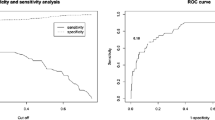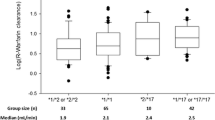Abstract
Objective
The objective of this study was to assess the contribution of the VKORC1 and CYP2C9 genotypes and age, body size, and weight of the patients to the warfarin dose requirement in a Chinese population.
Methods
Blood samples were collected from 178 Chinese patients with stable warfarin dose requirements and an international normalized ratio (INR) of the prothrombin time within the target range (1.5–3.0). The polymorphisms for the VKORC1 (-1639GA) and CYP2C9*3 genotypes, venous INR, and plasma concentration and unbound concentration of warfarin were then analyzed.
Results
VKORC1 (-1639G>A) genotyping showed that 149 patients were homozygous AA, 28 were heterozygous GA, and one was homozygous for the GG genotype. CYP2C9*3 genotyping showed that 162 patients were *1/*1, and 16 patients were heterozygous *1/*3. Patients with the VKORC1(-1639 GG+GA) (3.32 ± 1.02 mg/day) and CYP2C9*1/*1 (2.06 ± 0.82 mg/day) genotypes required a significantly higher warfarin dose than those with the -1639 AA (1.76 ± 0.57 mg/day; P < 0.001) or CYP2C9*1/*3 (1.60 ± 1.29 mg/day; P < 0.001), genotype. The multiple linear regression model for warfarin dose indicated significant contributions from age (r 2 = 0.084; P < 0.001), weight (r 2 = 0.063; P < 0.001), VKORC1 genotype (r 2 = 0.494; P < 0.001), and age, weight, and CYP2C9 and VKORC1 genotype together (r 2 = 0.628; P < 0.001).
Conclusion
This study shows that age, weight and the VKORC1 and CYP2C9 polymorphism affect warfarin dose requirements in our sample of Chinese patients receiving long-term therapy and showing stable control of anticoagulation. It is anticipated that the use of dosing regimens modified by taking into account the contribution of age, weight, and the CYP2C9 and VKORC1 genotypes has the potential to improve the safety of warfarin therapy.


Similar content being viewed by others
References
Rost S, Fregin A, Ivaskevicius V, Conzelmann E, Hortnagel K, Pelz HJ, Lappegard K, Seifried E, Scharrer I, Tuddenham EG, Muller CR, Strom TM, Oldenburg J (2004) Mutations in VKORC1 cause warfarin resistance and multiple coagulation factor deficiencytype2. Nature 427:537–541
Li T, Chang CY, Jin DY, Lin PJ, Khvorova A, Stafford DW (2004) Identification of the gene for vitamin K epoxide reductase. Nature 427:541–544
Bodin L, Verstuyft C, Tregouet DA, Robert A, Dubert L, Funck-Brentano C, Jaillon P, Beaune P, Laurent-Puig P, Becquemont L, Loriot MA (2005) Cytochrome P450 2C9 (CYP2C9) and vitamin K epoxide reductase (VKORC1) genotypes as determinants of acenocoumarol sensitivity. Blood 106:135–140
Wadelius M, Chen LY, Downes K, Ghori J, Hunt S, Eriksson N, Wallerman O, Melhus H, Wadelius C, Bentley D, Deloukas P (2005) Common VKORC1 and GGCX polymorphisms associated with warfarin dose. Pharmacogenomics J 5:262–270
Yuan HY, Chen JJ, Lee MT, Wung JC, Chen YF, Charng MJ (2005) A novel functional VKORC1 promoter polymorphism is associated with inter-individual and inter-ethnic diffdrences in warfarin sensitivity. Hum Mol Genet 14:1745–1751
D’Andrea G, D’Ambrosio RL, Di Perna P, Chetta M, Santacroce R, Brancaccio V (2005) A polymorphism in the VKORC1 gene is associated with an interindividual variability in the dose-anticoagulant effect of warfarin. Blood 105:645–649
Rieder MJ, Reiner AP, Gage BF, Nickerson DA, Eby CS, McLeod H (2005) Effect of VKORC1 haplotypes on transcriptional regulation and warfarin dose. N Engl J Med 352:2285–2293
Gedge J, Orme S, Hampton KK, Channer KS, Hendra TJ (2000) A comparison of a low dose warfarin induction regimen with the modified Fennertyregimen in elderly inpatients. Age Ageing 29:31–34
Wilkinson T, Sainsbury R (2003) Evaluation of a warfarin initiation protocol for older people. Intern Med J 33:465–467
Poller L, Shiach CR, MacCallum PK, Johansen AM, Munster AM, Magalhaes A, Jespersen J (1998) Multicentre randomised study of computerised anticoagulant dosage. Lancet 352:1505–1509
Fennerty A, Dolben J, Thomas P (1984) Flexible induction regimen for warfarin and prediction of maintenance dose. Br Med J (Clin Res Ed) 288:1268–1270
Hamberg AK, Dahl ML, Barban M, Scordo MG, Wadelius M, Pengo V, Padrini R, Jonsson EN (2007) A PK-PD model for predicting the impact of age, CYP2C9, and VKORC1 genotype on individualization of warfarin therapy. Clin Pharmacol Ther 81:529–538
Millican E, Jacobsen-Lenzini PA, Milligan PE, Grosso L, Eby C, Deych E, Grice G, Clohisy JC, Barrack RL, Burnett RS, Voora D, Gatchel S, Tiemeier A, Gage BF (2007) Genetic-based dosing in orthopaedic patients beginning warfarin therapy. Blood 110:1511–15115
Cho HJ, Sohn KH, Park HM, Lee KH, Choi B, Kim S, Kim JS, On YK, Chun MR, Kim HJ, Kim JW, Lee SY (2007) Factors affecting the interindividual variability of warfarin dose requirement in adult Korean patients. Pharmacogenomics 8:329–337
Paul MR, Samuel ZG, Ellie D, Yves R, Charles SE et al (2003) Long-term, low-intensity warfarin therapy for the prevention of recurrent venous thromboembolism. N Engl J Med 348:1425–1434
Sun YH, Hu DY (2004) The efficiency and safety of anticoagulation therapy in atrial fibrillation in Chinese. Clin J Intern Med 43:258–260
Yamaguchi T (2000) Optimal intensity of warfain therapy for secondary prevention of stroke in patients with nonvalvular atrial fibrillation: a multicenter, prospective randomized trial. Stroke 31:817–821
Veenstra DL, You JH, Rieder MJ, Farin FM, Wilkerson HW, Blough DK, Cheng G, Rettie AE (2005) Association of Vitamin K epoxide reductase complex 1 (VKORC1) variants with warfarin dose in a Hong Kong Chinese patient population. Pharmacogenet Genomics 15:687–691
Loebstein R, Yonath H, Peleg D, Almog S, Rotenberg M, Lubetsky A et al (2001) Interindividual variability in sensitivity to warfarin-nature or nurture? Clin Pharmacol Ther 70:159–164
Hillman MA, Wilke RA, Caldwell MD, Berg RL, Glurich I, Burmester JK (2004) Relative impact of covariates in prescribing warfarin according to CYP2C9 genotype. Pharmacogenetics 14:539–547
Kamali F, Khan TI, King BP, Frearson R, Kesteven P, Wood P et al. (2004) Contribution of age, body size, and CYP2C9 genotype to anticoagulant response to warfarin. Clin Pharmacol Ther 75:204–212
Kohnke H, Sorlin K, Granath G, Wadelius M (2005) Warfarin dose related to apolipoprotein E (APOE) genotype. Eur J Clin Pharmacol 5–6:381–388
Sconce EA, Daly AK, Khan TI, Wynne HA, Kamali F (2006) APOE genotype makes a small contribution to warfarin dose requirements. Pharmacogenet Genomics 16:609–611
Wadelius M, Sorlin K, Wallerman O, Karlsson J, Yue QY, Magnusson PK (2004) Warfarin sensitivity related to CYP2C9, CYP3A5, ABCB1 (MDR1) and other factors. Pharmacogenomics J 4:40–48
Shikata E, Ieiri I, Ishiguro S, Aono H, Inoue K, Koide T, Ohgi S, Otsubo K (2004) Association of pharmacokinetic (CYP2C9) and pharmacodynamic (factorsII,VII,IX,andX; proteins S and C;and r-glutamyl carboxylase) gene variants with warfarin sensitivity. Blood 103:2630–2635
Chen LY, Eriksson N, Gwilliam R, Bentley D, Deloukas P (2005) Wadelius M Gamma-glutamyl carboxylase (GGCX) microsatellite and warfarin dosing. Blood 106:3673–3674
Loebstein R, Vecsler M, Kurnik D, Austerweil N, Gak E, Halkin H (2005) Common genetic variants of microsomal epoxide hydrolase affect warfarin dose requirements beyond the effect of cytochrome P4502C9. Clin Pharmacol Ther 77:365–372
Vecsler M, Loebstein R, Almog S, Kurnik D, Goldman B, Halkin H, Gak E (2006) Combined genetic profiles of components and regulators of the vitamin K-dependent gamma-carboxylation system affect individual sensitivity to warfarin. Thromb Haemost 95:205–211
Acknowledgements
We thank all doctors, nurses and patients who took part in this study. This study was supported by the Department of Clinical Pharmacology Research Lab, the First Affiliated Hospital of Soochow University. The experiments comply with current laws of China. The Ethics Committee of the First Affiliated Hospital of Soochow University approved the study. The authors declare that there are no competing interests.
Author information
Authors and Affiliations
Corresponding author
Rights and permissions
About this article
Cite this article
Miao, L., Yang, J., Huang, C. et al. Contribution of age, body weight, and CYP2C9 and VKORC1 genotype to the anticoagulant response to warfarin: proposal for a new dosing regimen in Chinese patients. Eur J Clin Pharmacol 63, 1135–1141 (2007). https://doi.org/10.1007/s00228-007-0381-6
Received:
Accepted:
Published:
Issue Date:
DOI: https://doi.org/10.1007/s00228-007-0381-6




